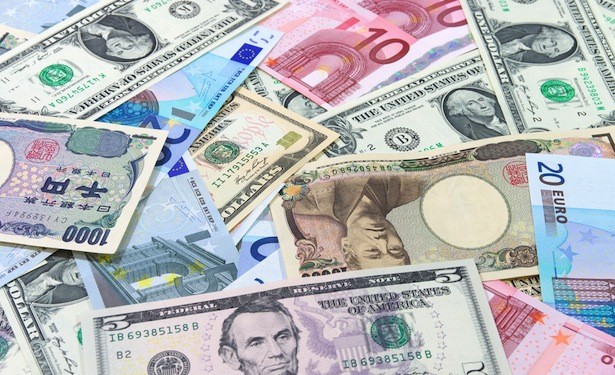Beware the Currency Wars of 2015
Post on: 16 Август, 2015 No Comment

Provided by The Wall Street Journal.
It will be very difficult to avoid deflation and promote growth in 2015 and beyond without major changes to the global monetary system, some of which are unthinkable right now. Policy makers in Asia and Europe are already devaluing their currencies, apparently driven by the failure of low interest rates to stimulate investment and by the recognition that the U.S. is the only place that is showing real growth. Making their exports cheaper, they believe, will help their economies grow.
The problem is that if every country devalues its currency, no one wins. And if devaluations become more aggressive and disorderly, it could create great systemic risks world-wide. Dollar borrowers would struggle to find liquidity. U.S. corporations would see their export markets evaporate. And emerging markets would be forced to raise their interest rates dramatically to prevent their currencies from collapsing.
The dollar is already at a nine-year high against other major currencies. In Asia, the yen, thanks to the Bank of Japan’s unprecedented and ongoing quantitative easing, is now seriously undervalued versus the yuan and other regional currencies. China in turn has begun to allow the yuan to weaken. Beijing is in a bind as it seeks to grow the economy. It needs to deflate the wild lending boom of recent years, which rules out traditional monetary easing, and fiscal policy runs up against a lack of suitable projects and ruinous local government finances. For China, devaluation is the only show in town.
But any significant devaluation by China will put more downward pressure on the yen. At some point, could the yen collapse? With a government debt/GDP ratio already near 250%, Japan might have a bond-market crisis that would have to be met with even more policy easing, creating a vicious cycle of yen and bond-market weakness. While it isn’t clear if this scenario would occur, it is obvious that devaluations must be orderly to minimize the risk.
European Central Bank President Mario Draghi has been focused on the level of the euro—particularly versus the yen—for some time. He has engineered a moderate devaluation but has failed to get the kind of monetary first strike on growth and deflation he was seeking. It looks like some kind of quantitative easing by the ECB is next, as doctrinal and legal objections from Germany and doubts elsewhere about the effectiveness of QE are being shelved. But there is clearly not the appetite in Europe for the whatever-it-takes approach of the Federal Reserve and the Bank of Japan.
But if the ECB’s purchase of sovereign debt fails to boost growth and stop disinflation, where does eurozone policy go next? The ECB may have no option other than to target the exchange rate. It could decide to manage the euro at a very competitive rate versus a basket of major currencies. This would be an easy sell politically within the eurozone, particularly in Germany.
If we do see major currency moves in Asia in the near future and a radical shift in policy in the eurozone later in the year, smaller economies such as the U.K. would also feel the heat and be compelled to follow.
This would be unwelcome news in the U.S. While the dollar’s recent rise is not by itself catastrophic, U.S. policy makers would be furious if other countries try to “steal” growth by putting American exports at a disadvantage. But there is probably little that can be done to stop these competitive devaluations once they begin.
The Fed could theoretically keep interest rates at or near historic lows far beyond 2015, hoping that this would reduce the attraction of owning dollars. But this is problematic if the recent spurt of U.S. growth continues or accelerates. The Federal Open Market Committee is committed to bringing interest rates up to a historically more normal level. Aside from the dollar legally being a Treasury Department responsibility, the Fed’s primary concern is the systemic risks from domestic asset bubbles if policy is not tightened as growth picks up, not baby-sitting countries that are devaluing.
The situation demands policy coordination. Seismic shifts are coming in exchange rates in 2015 whether Washington likes it or not, and policy makers need to get ahead of the curve. The U.S. can show global leadership by opening up a process to coordinate Asian and European devaluation—a dynamic that will also lend badly needed stability to emerging markets.
There is historical precedent for this. In 1985 the U.S. France, West Germany, Japan and U.K. signed the Paris Accord to manage the devaluation of the dollar. Two years later the Louvre Accord reversed this process. While big international agreements are never easy, the major positive is that everyone’s interests would be aligned if a “New Louvre” agreement was drawn up among the U.S. the eurozone, Japan and China.
The world may ultimately be heading toward a global managed exchange rate regime. This may sound far-fetched, but policy makers have already fixed the price of government bonds in the aftermath of the 2008 global financial crisis. Why should they stop there? And if they don’t do something, then the disorder that potentially lies ahead in foreign-exchange markets could spark major systemic problems and undo much of the healing that has taken place since 2008.
Mr. Newton, a former macro trader for Caxton Associates LLC and global head of emerging market FX strategy for HSBC, is an independent commentator on global markets.














